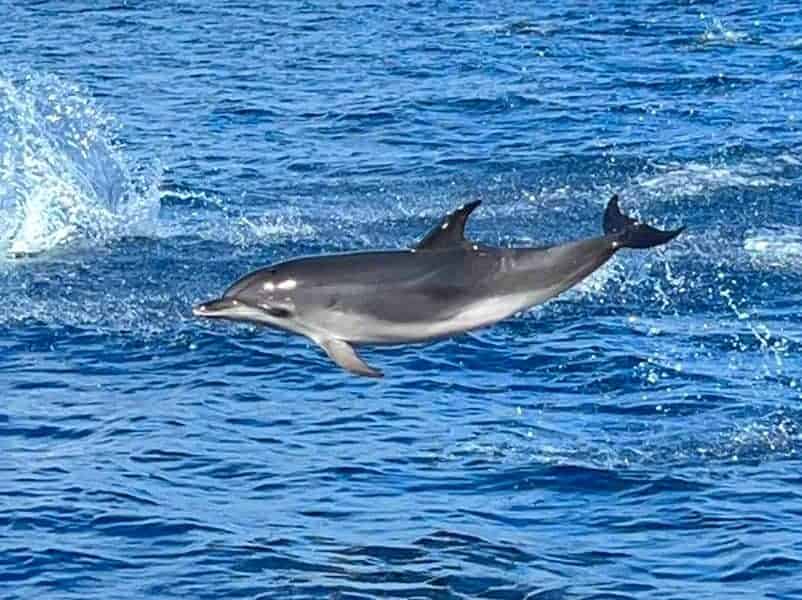Types of Ceteans in Gran Canaria
Enjoying a boat excursion to see cetaceans in Gran Canaria is one of the most sought-after and fascinating experiences you shouldn’t miss during your visit to the island. The combination of an abundant food source, deep waters near the coast, ideal water temperature, and its strategic location as a migratory transition point for nomadic species make Gran Canaria a paradise for cetacean watching. In the Canary Archipelago, 28 of the 90 cetacean species that exist in the world can be found. Although the bottlenose dolphin is the most common in our excursions, here are some of the species you may encounter and their characteristics.
Dolphins
- Bottlenose Dolphin (Tursiops truncatus): The bottlenose dolphin is the best known and can be easily spotted near the coast of Gran Canaria. Males measure on average 2.7 metres, while females reach 2.5 metres, although some specimens can exceed 3 metres. They live in groups of 10 to 30 individuals, and their colour ranges from dark grey on the back to lighter tones on the underside.
- Atlantic Spotted Dolphin (Stenella frontalis): Known for the spots that cover its skin upon reaching maturity, this dolphin forms large groups and is very active. It can be observed more frequently between autumn and late spring.
- Rough-toothed Dolphin (Steno bredanensis): This dolphin is distinguished by the ridges on its teeth and its elongated skull. It is darker than the bottlenose dolphin and has light spots. Generally, it is found in groups of 6 to 10 individuals.
- Striped Dolphin (Stenella coeruleoalba): Recognisable by its blue colour and the stripes that extend from the eyes to almost the tail, the striped dolphin sometimes avoids boats but is a fast swimmer and likes to leap out of the water.
- Common Dolphin (Delphinus delphis): This dolphin is easy to identify by its yellowish colouring on the flanks. Although it can be seen all year round, it is more common in winter.
Other Cetaceans
- Short-finned Pilot Whale (Globicephala macrorhynchus): Also known as the “Pilot Whale,” this cetacean belongs to the dolphin family. Despite its name, it is a toothed whale, and its considerable size has earned it the title of whale.
- Bryde’s Whale (Balaenoptera edeni): Similar in appearance to the sei whale, the Bryde’s whale is smaller and more robust, with three dorsal ridges instead of one. Males measure up to 13.7 metres, and females up to 14.5 metres, with a maximum of 15 metres. Its back is dark bluish-grey, while the sides and belly are lighter.
- Risso’s Dolphin (Grampus griseus): Similar to the short-finned pilot whale, Risso’s dolphin is distinguished by its grey skin, which can be almost white in some adults, and its dark dorsal fin.
- Sperm Whale (Physeter macrocephalus): The sperm whale is the largest of the toothed whales, comparable in size to the baleen whales. It stands out for its enormous head, wrinkled and dark skin, and small dorsal fin. It can dive for over an hour to feed at depths of more than 2,000 metres, being most visible in spring.
- Fin Whale (Balaenoptera physalus): The fin whale is recognisable by its colouring, with the back and sides being a dark tone that turns white towards the underside. The head is asymmetrical, with the right side being lighter and the jaw white, while the left side is darker with the jaw and part of the throat dark grey.
- Sei Whale (Balaenoptera borealis): This whale reaches 17.1 metres in males and 18.6 metres in females, and can weigh up to 25 tonnes. Similar to Bryde’s whale, it is larger and slender, with a single ridge on the face. Its general colouring is dark grey or brown, with a whitish ventral part.
- False Killer Whale (Pseudorca crassidens): The false killer whale has a slender body with a dorsal fin approximately 30 cm high. It is distinguished by a curve and a bulge halfway along its fins. Its colour is uniform, from dark grey to black, and it lives in groups of 10 to 50 individuals, showing social behaviour.

